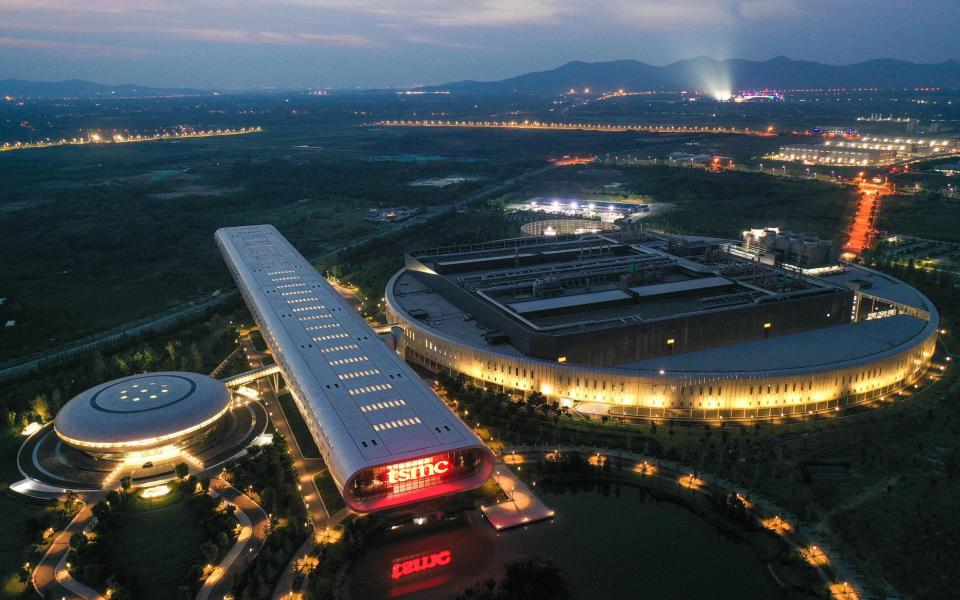The iPhone may be designed in California and assembled in China, but its brains are built in Taiwan.
For a decade, Apple’s “A-series” microchips, which are among the world’s most advanced processors, have been manufactured by Taiwan Semiconductor Manufacturing Company (TSMC), whose technological prowess has made it Asia’s most valuable company.
Apple is TSMC’s biggest customer and its chips are made exclusively in Taiwan, where the company’s most cutting-edge megafactories are located.
Until now. This week, reports emerged that TSMC is making Apple processors in the USA for the first time. Tim Culpan, a well-connected independent journalist based in Taipei, revealed that TSMC’s new plant in Arizona was churning out Apple’s A16 chips.
Neither Apple nor TSMC would confirm the report, and the chip in question is not Apple’s most powerful. It is a couple of years old, and when it makes it into products, they are likely to be cheaper entry-level iPads or iPhones.
But the news was still a big deal, or in Culpan’s words, “a BFD”.
“The fact that they went for the most-advanced chip they could manage on US soil, in terms of both technology and volume, shows Apple and TSMC want to start big,” he wrote.
The success of Apple chip production in America is a major achievement of Joe Biden’s $53bn (£40bn) Chips and Science Act, a mammoth piece of industrial policy designed to encourage advanced semiconductor manufacturing in the US.
The act provides billions in subsidies and loans to companies such as TSMC. The Biden administration hopes it will reverse what is seen as a precarious drift of advanced chip manufacturing towards Asia and particularly Taiwan. The island is democratically governed but coveted by Xi Jinping, and the most likely epicentre of any conflict between the US and China. This makes it a precarious source of the semiconductors that sit in phones, computers and data centres.
The US invented the microchip, but no longer makes the most advanced ones. In recent decades, Japan, then South Korea, and more recently Taiwan surpassed the US in high-volume production. TSMC, set up in 1986 with huge support from a rapidly-democratising government, pioneered the “foundry” business model, in which the company does not design its own chips but makes them for customers in hugely-expensive factories.

The model has come to rule the industry as the transistors from which semiconductors are made have become physics-bendingly small (TSMC recently started initial production of 2 nanometre transistors, 50bn of which would fit on a fingernail).
This has led to TSMC, and Taiwan, dominating advanced chip production. The US share of global chip manufacturing has fallen from 37pc in 1990 to 12pc in 2021. Europe’s share has fallen even more dramatically, from 44pc to 9pc. Taiwan has gone from practically nothing to more than 60pc – and 92pc of the most advanced chips.
For decades, politicians largely ignored this, while companies were happy to outsource manufacturing to save money. Intel, the last remaining “integrated” manufacturer in the US, failed to invest in expensive hardware to remain at the cutting edge.
But the rise of an increasingly-assertive China, along with supply shortages during the pandemic, has forced Western governments to pay attention. Xi has told the People’s Liberation Army to be ready to invade Taiwan by 2027. One possible reason why he has not done so to date is the havoc it would cause on technological supply chains, which are crucial to China’s manufacturing sector.
Taiwanese politicians have often referred to the country’s manufacturing sector as a “silicon shield”, securing the island against invasion. TSMC itself has been labelled the “sacred mountain of protection”.
Not everyone is so comfortable with this situation, though. “The US and the rest of the world is in this precarious situation where it relies on Taiwan for advanced chip manufacturing, but it really has no other choice,” says Jimmy Goodrich, a senior technology adviser to the Rand Corporation.
“In case of a crisis over Taiwan or even another pandemic, [the US] needs to have some onshore sources of microelectronics. It’s just too strategically important to not have it.”
The billions of funds handed to TSMC, Intel and others to make chips in America therefore puts the US and Taiwan at odds. America wishes to reduce its reliance on Taiwan in case China invades; Taiwan needs to maintain that reliance to stay geopolitically relevant.


Chris Miller, a US historian and author of Chip War, a book about the geopolitics of the semiconductor industry, says that Apple chips being made in the US is a “meaningful step one”.
“I don’t think we should overstate the ways in which this might change the calculus around Taiwan in the short run. It’s meaningful, but on its own, not an immediate, drastic, overnight change. There’s still immense reliance on production in Taiwan.”
Miller adds that the effect of the silicon shield may be overstated, since US economic reliance on Taiwan could in fact give China leverage in a blockade scenario.
The US subsidies have, nonetheless, been contentious in Taiwan. The Semiconductor Industry Association, a US industry body, predicts that the island’s control over production of the most advanced semiconductors will fall to 47pc by 2032. The US will go from nothing to 28pc.
The prospect of Donald Trump returning to the White House presents another possible complication. In July, Trump claimed Taiwan “took almost 100pc of our chip industry” adding “we should have never let that happen”.
Goodrich says that Apple’s move makes little difference in the short term. “[The industry] was built over four decades with hundreds of billions of dollars of investment. Not even tens of billions of dollars of investment can change that immediately and overnight.” TSMC itself has said it is fully committed to its home country, calling Taiwan its first, second and third priority.
But America becoming more self-reliant can only make it less exposed to the island off China’s coast. If there are more cases like Apple, Taiwan’s silicon shield might start to crack.
